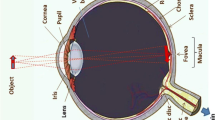Abstract
Digital imaging systems can be used for direct acquisition of images of the ocular fundus or for their indirect acquisition from fundus photographs or transparencies. Computerised image processing techniques can then be used to manipulate and quantify features of interest. We describe a method for the detection and quantification of macular leakage in fluorescein angiograms. The rate of change in fluorescence over time is examined on a pixel-by-pixel basis and used to provide a gradient threshold that discriminates pixels displaying leakage from normal pixels. A region-growing technique is then used to enhance the detection of leakage missed by gradient thresholding alone. This report discusses the potential applications of the technique and highlights the methodology required to obtain reproducible results.
Similar content being viewed by others
References
Baudoin CE, Lay BJ, Klein JC (1984) Automatic detection of microaneurysms in diabetic fluorescein angiography. Rev Epidemiol Saute Publique 32:254–261
Caprioli J, Klingbell U, Sears M, Pope B (1987) Reproducibility of optic disc measurements with computerised analysis of stereoscopic video images. Arch Ophthalmol 104:1035–1039
Diabetic Retinopathy Study, report 7 (1981) A modification of the Airlie House classification of diabetic retinopathy. Invest Ophthalmol Vis Sci 21:210–216
Friberg TR, Rehkopf PG, Warnicki JW, Eller AW (1987) Use of directly acquired digital fundus and fluorescein angiographic images in the diagnosis of retinal disease. Retina 7:246–251
Gerlot P, Bizais Y (1988) Image registration: a review and a strategy for medical applications. In: Graaf CN de, Viergever NA (eds) Information processing in medical imaging. Plenum Press, New York
Peli E, Lahav M (1983) Drusen measurement from fundus photographs using computer image analysis. Ophthalmology 93:1575–1580
Rosenfeld A, Kak AC (1982) Digital picture processing. Academic Press, Orlando, pp 61–73
Varma R, Spaeth GL (1988) The PAR is 2000: a new system for retinal digital image analysis. Ophthalmic Surg 19:183–192
Ward NP, Tomlinson S, Taylor CJ (1989) Image analysis of fundus photographs. The detection and measurement of exudates associated with diabetic retinopathy. Ophthalmology 96:80–86
Author information
Authors and Affiliations
Additional information
Offprint requests to: R.P. Phillips
Rights and permissions
About this article
Cite this article
Phillips, R.P., Ross, P.G., Tyska, M. et al. Detection and quantification of hyperfluorescent leakage by computer analysis of fundus fluorescein angiograms. Graefe's Arch Clin Exp Ophthalmol 229, 329–335 (1991). https://doi.org/10.1007/BF00170690
Received:
Accepted:
Issue Date:
DOI: https://doi.org/10.1007/BF00170690




